Fringe Benefit Tax Calculation for Company Drivers - Finance
VerifiedAdded on 2023/01/18
|6
|1279
|71
Homework Assignment
AI Summary
This document presents a comprehensive solution to a fringe benefit tax (FBT) assignment, focusing on the calculation of FBT for company drivers using both the statutory and operating cost methods. The assignment analyzes four different drivers, each with varying car values, business use percentages, and employee contributions. For each driver, the FBT payable is calculated using both methods, and the most suitable method (resulting in lower FBT) is identified. The calculations include depreciation, deemed interest, and total operating costs, providing a detailed breakdown of the financial implications of each method. The document demonstrates the application of FBT principles and provides insights into choosing the optimal calculation method for minimizing tax liabilities. The solution includes all the workings for a better understanding.
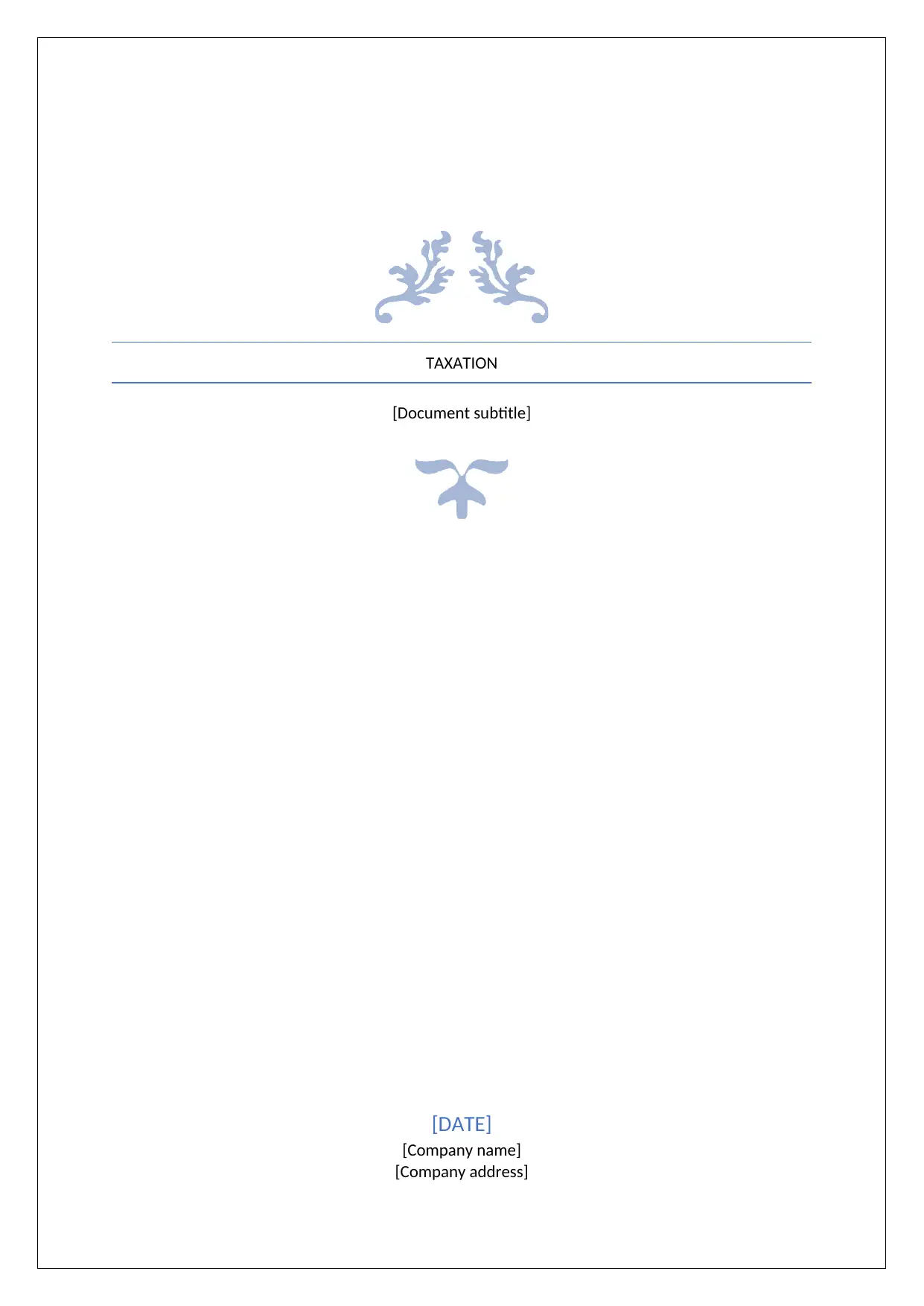
TAXATION
[Document subtitle]
[DATE]
[Company name]
[Company address]
[Document subtitle]
[DATE]
[Company name]
[Company address]
Paraphrase This Document
Need a fresh take? Get an instant paraphrase of this document with our AI Paraphraser
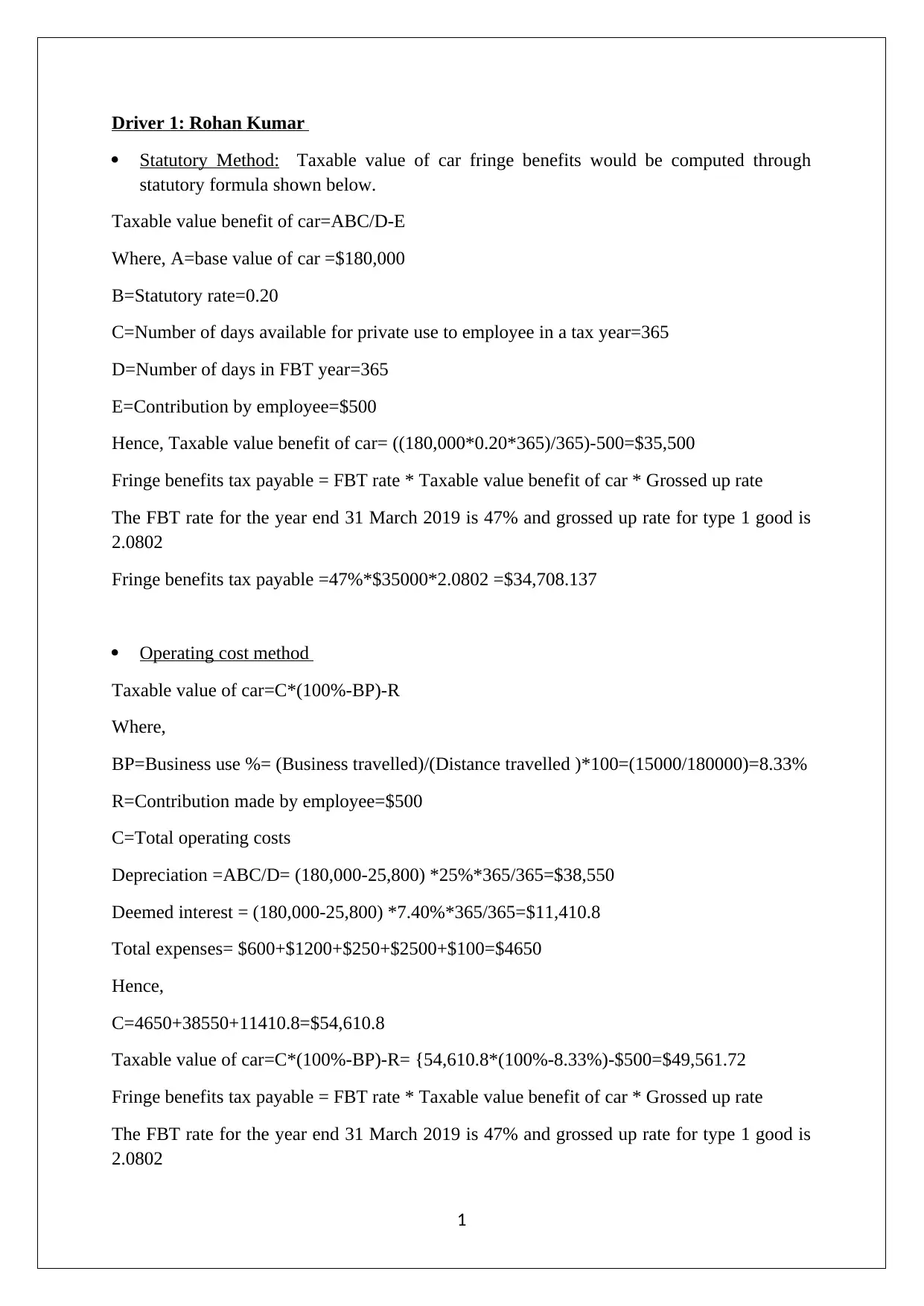
Driver 1: Rohan Kumar
Statutory Method: Taxable value of car fringe benefits would be computed through
statutory formula shown below.
Taxable value benefit of car=ABC/D-E
Where, A=base value of car =$180,000
B=Statutory rate=0.20
C=Number of days available for private use to employee in a tax year=365
D=Number of days in FBT year=365
E=Contribution by employee=$500
Hence, Taxable value benefit of car= ((180,000*0.20*365)/365)-500=$35,500
Fringe benefits tax payable = FBT rate * Taxable value benefit of car * Grossed up rate
The FBT rate for the year end 31 March 2019 is 47% and grossed up rate for type 1 good is
2.0802
Fringe benefits tax payable =47%*$35000*2.0802 =$34,708.137
Operating cost method
Taxable value of car=C*(100%-BP)-R
Where,
BP=Business use %= (Business travelled)/(Distance travelled )*100=(15000/180000)=8.33%
R=Contribution made by employee=$500
C=Total operating costs
Depreciation =ABC/D= (180,000-25,800) *25%*365/365=$38,550
Deemed interest = (180,000-25,800) *7.40%*365/365=$11,410.8
Total expenses= $600+$1200+$250+$2500+$100=$4650
Hence,
C=4650+38550+11410.8=$54,610.8
Taxable value of car=C*(100%-BP)-R= {54,610.8*(100%-8.33%)-$500=$49,561.72
Fringe benefits tax payable = FBT rate * Taxable value benefit of car * Grossed up rate
The FBT rate for the year end 31 March 2019 is 47% and grossed up rate for type 1 good is
2.0802
1
Statutory Method: Taxable value of car fringe benefits would be computed through
statutory formula shown below.
Taxable value benefit of car=ABC/D-E
Where, A=base value of car =$180,000
B=Statutory rate=0.20
C=Number of days available for private use to employee in a tax year=365
D=Number of days in FBT year=365
E=Contribution by employee=$500
Hence, Taxable value benefit of car= ((180,000*0.20*365)/365)-500=$35,500
Fringe benefits tax payable = FBT rate * Taxable value benefit of car * Grossed up rate
The FBT rate for the year end 31 March 2019 is 47% and grossed up rate for type 1 good is
2.0802
Fringe benefits tax payable =47%*$35000*2.0802 =$34,708.137
Operating cost method
Taxable value of car=C*(100%-BP)-R
Where,
BP=Business use %= (Business travelled)/(Distance travelled )*100=(15000/180000)=8.33%
R=Contribution made by employee=$500
C=Total operating costs
Depreciation =ABC/D= (180,000-25,800) *25%*365/365=$38,550
Deemed interest = (180,000-25,800) *7.40%*365/365=$11,410.8
Total expenses= $600+$1200+$250+$2500+$100=$4650
Hence,
C=4650+38550+11410.8=$54,610.8
Taxable value of car=C*(100%-BP)-R= {54,610.8*(100%-8.33%)-$500=$49,561.72
Fringe benefits tax payable = FBT rate * Taxable value benefit of car * Grossed up rate
The FBT rate for the year end 31 March 2019 is 47% and grossed up rate for type 1 good is
2.0802
1
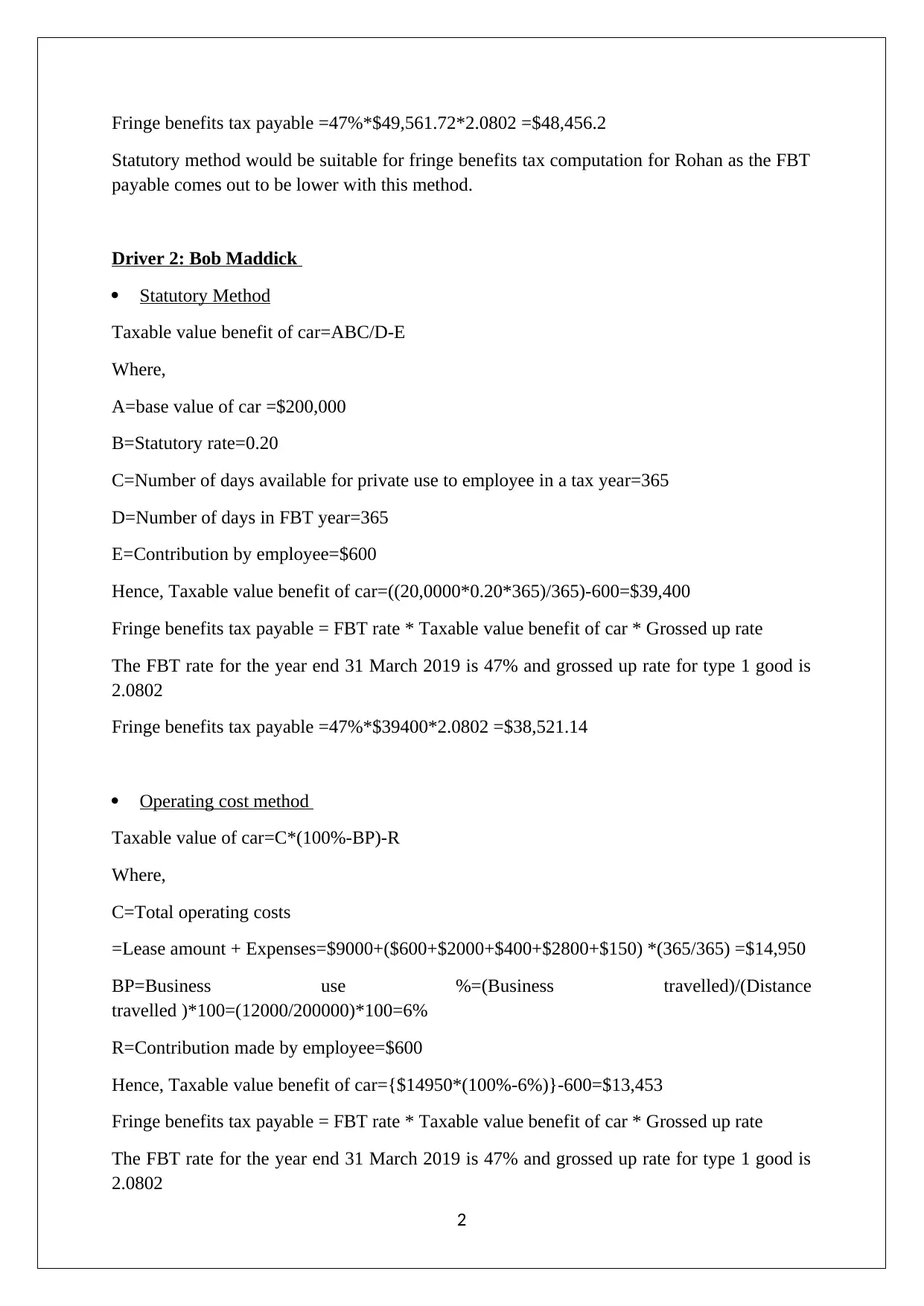
Fringe benefits tax payable =47%*$49,561.72*2.0802 =$48,456.2
Statutory method would be suitable for fringe benefits tax computation for Rohan as the FBT
payable comes out to be lower with this method.
Driver 2: Bob Maddick
Statutory Method
Taxable value benefit of car=ABC/D-E
Where,
A=base value of car =$200,000
B=Statutory rate=0.20
C=Number of days available for private use to employee in a tax year=365
D=Number of days in FBT year=365
E=Contribution by employee=$600
Hence, Taxable value benefit of car=((20,0000*0.20*365)/365)-600=$39,400
Fringe benefits tax payable = FBT rate * Taxable value benefit of car * Grossed up rate
The FBT rate for the year end 31 March 2019 is 47% and grossed up rate for type 1 good is
2.0802
Fringe benefits tax payable =47%*$39400*2.0802 =$38,521.14
Operating cost method
Taxable value of car=C*(100%-BP)-R
Where,
C=Total operating costs
=Lease amount + Expenses=$9000+($600+$2000+$400+$2800+$150) *(365/365) =$14,950
BP=Business use %=(Business travelled)/(Distance
travelled )*100=(12000/200000)*100=6%
R=Contribution made by employee=$600
Hence, Taxable value benefit of car={$14950*(100%-6%)}-600=$13,453
Fringe benefits tax payable = FBT rate * Taxable value benefit of car * Grossed up rate
The FBT rate for the year end 31 March 2019 is 47% and grossed up rate for type 1 good is
2.0802
2
Statutory method would be suitable for fringe benefits tax computation for Rohan as the FBT
payable comes out to be lower with this method.
Driver 2: Bob Maddick
Statutory Method
Taxable value benefit of car=ABC/D-E
Where,
A=base value of car =$200,000
B=Statutory rate=0.20
C=Number of days available for private use to employee in a tax year=365
D=Number of days in FBT year=365
E=Contribution by employee=$600
Hence, Taxable value benefit of car=((20,0000*0.20*365)/365)-600=$39,400
Fringe benefits tax payable = FBT rate * Taxable value benefit of car * Grossed up rate
The FBT rate for the year end 31 March 2019 is 47% and grossed up rate for type 1 good is
2.0802
Fringe benefits tax payable =47%*$39400*2.0802 =$38,521.14
Operating cost method
Taxable value of car=C*(100%-BP)-R
Where,
C=Total operating costs
=Lease amount + Expenses=$9000+($600+$2000+$400+$2800+$150) *(365/365) =$14,950
BP=Business use %=(Business travelled)/(Distance
travelled )*100=(12000/200000)*100=6%
R=Contribution made by employee=$600
Hence, Taxable value benefit of car={$14950*(100%-6%)}-600=$13,453
Fringe benefits tax payable = FBT rate * Taxable value benefit of car * Grossed up rate
The FBT rate for the year end 31 March 2019 is 47% and grossed up rate for type 1 good is
2.0802
2
⊘ This is a preview!⊘
Do you want full access?
Subscribe today to unlock all pages.

Trusted by 1+ million students worldwide
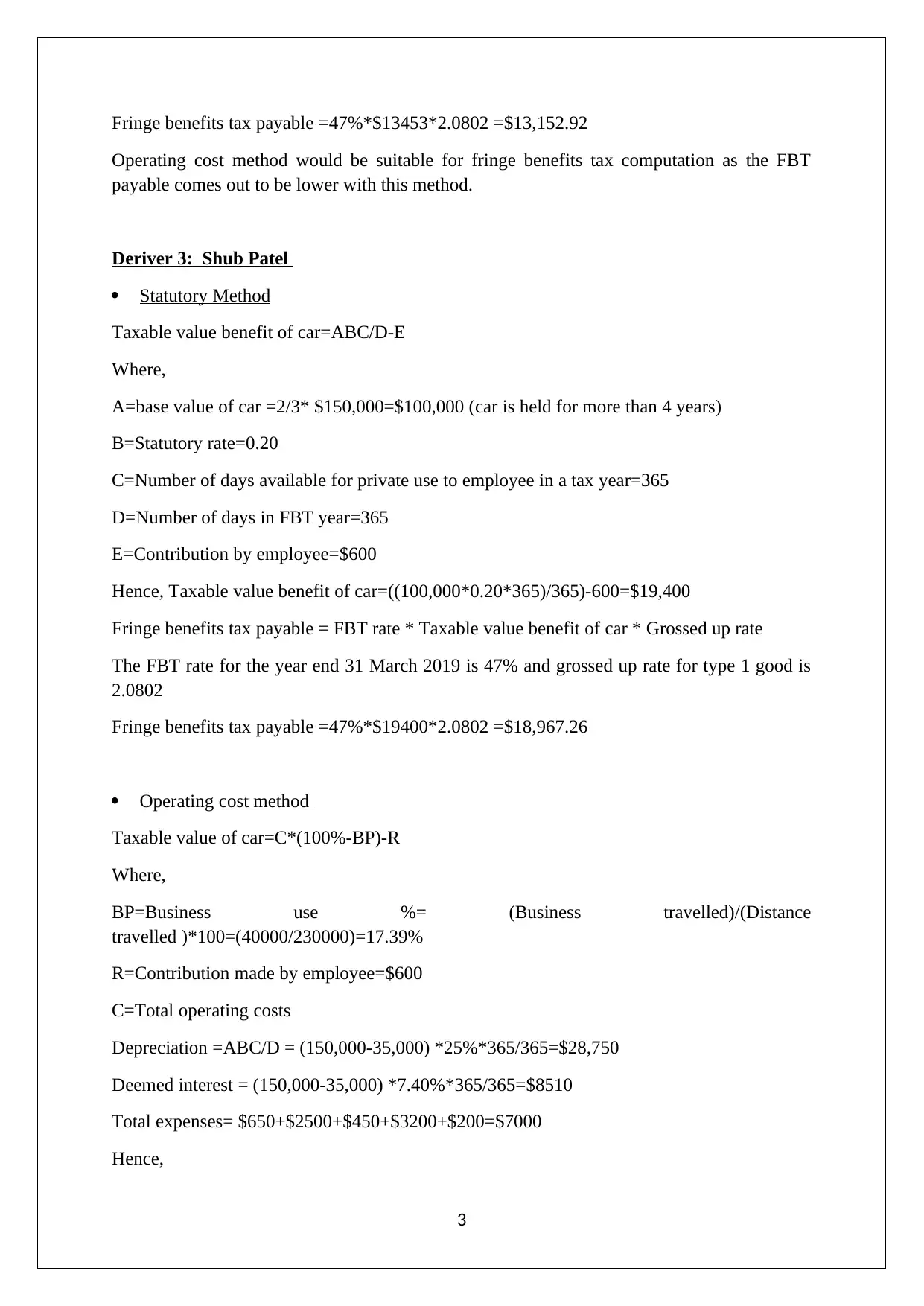
Fringe benefits tax payable =47%*$13453*2.0802 =$13,152.92
Operating cost method would be suitable for fringe benefits tax computation as the FBT
payable comes out to be lower with this method.
Deriver 3: Shub Patel
Statutory Method
Taxable value benefit of car=ABC/D-E
Where,
A=base value of car =2/3* $150,000=$100,000 (car is held for more than 4 years)
B=Statutory rate=0.20
C=Number of days available for private use to employee in a tax year=365
D=Number of days in FBT year=365
E=Contribution by employee=$600
Hence, Taxable value benefit of car=((100,000*0.20*365)/365)-600=$19,400
Fringe benefits tax payable = FBT rate * Taxable value benefit of car * Grossed up rate
The FBT rate for the year end 31 March 2019 is 47% and grossed up rate for type 1 good is
2.0802
Fringe benefits tax payable =47%*$19400*2.0802 =$18,967.26
Operating cost method
Taxable value of car=C*(100%-BP)-R
Where,
BP=Business use %= (Business travelled)/(Distance
travelled )*100=(40000/230000)=17.39%
R=Contribution made by employee=$600
C=Total operating costs
Depreciation =ABC/D = (150,000-35,000) *25%*365/365=$28,750
Deemed interest = (150,000-35,000) *7.40%*365/365=$8510
Total expenses= $650+$2500+$450+$3200+$200=$7000
Hence,
3
Operating cost method would be suitable for fringe benefits tax computation as the FBT
payable comes out to be lower with this method.
Deriver 3: Shub Patel
Statutory Method
Taxable value benefit of car=ABC/D-E
Where,
A=base value of car =2/3* $150,000=$100,000 (car is held for more than 4 years)
B=Statutory rate=0.20
C=Number of days available for private use to employee in a tax year=365
D=Number of days in FBT year=365
E=Contribution by employee=$600
Hence, Taxable value benefit of car=((100,000*0.20*365)/365)-600=$19,400
Fringe benefits tax payable = FBT rate * Taxable value benefit of car * Grossed up rate
The FBT rate for the year end 31 March 2019 is 47% and grossed up rate for type 1 good is
2.0802
Fringe benefits tax payable =47%*$19400*2.0802 =$18,967.26
Operating cost method
Taxable value of car=C*(100%-BP)-R
Where,
BP=Business use %= (Business travelled)/(Distance
travelled )*100=(40000/230000)=17.39%
R=Contribution made by employee=$600
C=Total operating costs
Depreciation =ABC/D = (150,000-35,000) *25%*365/365=$28,750
Deemed interest = (150,000-35,000) *7.40%*365/365=$8510
Total expenses= $650+$2500+$450+$3200+$200=$7000
Hence,
3
Paraphrase This Document
Need a fresh take? Get an instant paraphrase of this document with our AI Paraphraser
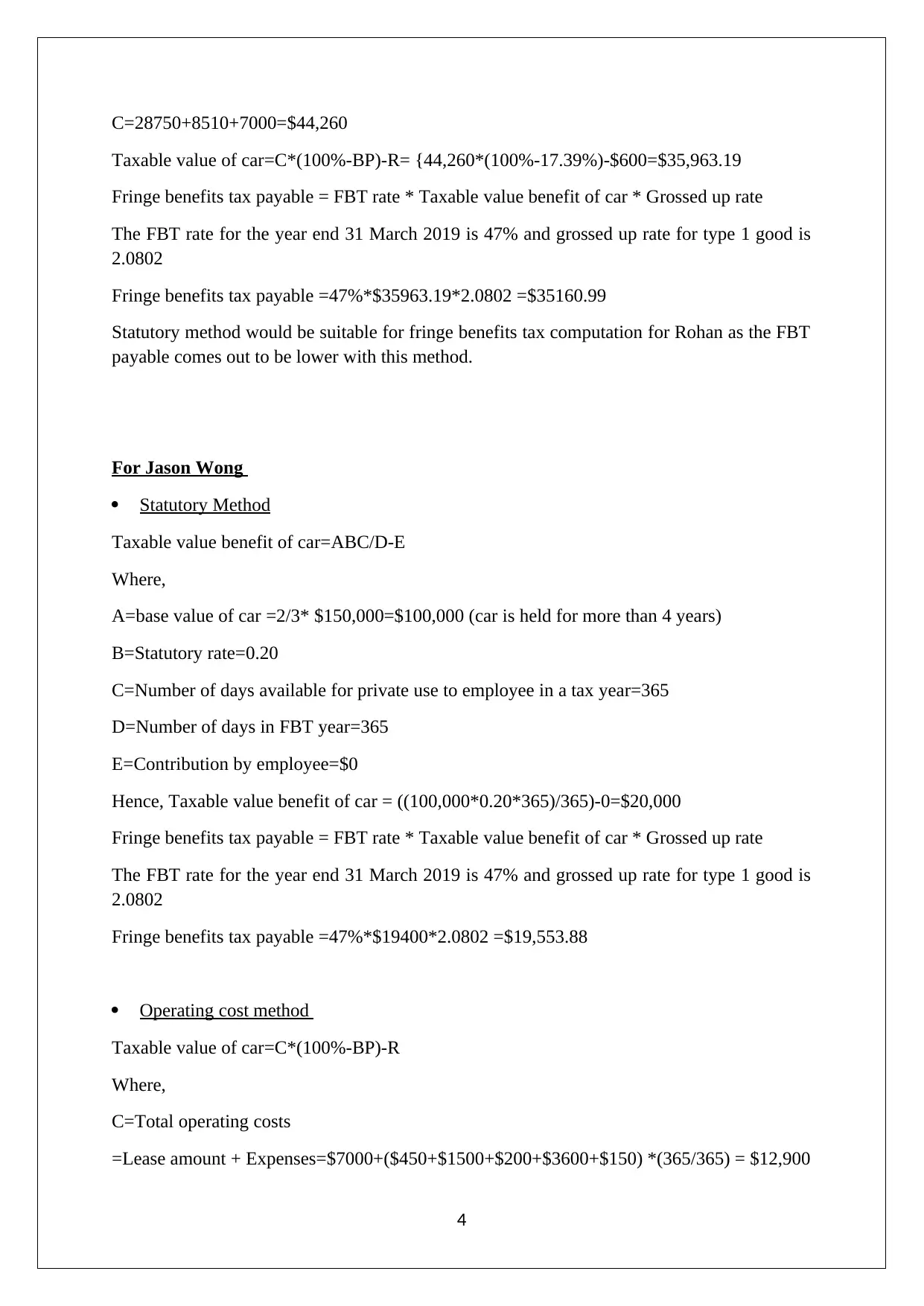
C=28750+8510+7000=$44,260
Taxable value of car=C*(100%-BP)-R= {44,260*(100%-17.39%)-$600=$35,963.19
Fringe benefits tax payable = FBT rate * Taxable value benefit of car * Grossed up rate
The FBT rate for the year end 31 March 2019 is 47% and grossed up rate for type 1 good is
2.0802
Fringe benefits tax payable =47%*$35963.19*2.0802 =$35160.99
Statutory method would be suitable for fringe benefits tax computation for Rohan as the FBT
payable comes out to be lower with this method.
For Jason Wong
Statutory Method
Taxable value benefit of car=ABC/D-E
Where,
A=base value of car =2/3* $150,000=$100,000 (car is held for more than 4 years)
B=Statutory rate=0.20
C=Number of days available for private use to employee in a tax year=365
D=Number of days in FBT year=365
E=Contribution by employee=$0
Hence, Taxable value benefit of car = ((100,000*0.20*365)/365)-0=$20,000
Fringe benefits tax payable = FBT rate * Taxable value benefit of car * Grossed up rate
The FBT rate for the year end 31 March 2019 is 47% and grossed up rate for type 1 good is
2.0802
Fringe benefits tax payable =47%*$19400*2.0802 =$19,553.88
Operating cost method
Taxable value of car=C*(100%-BP)-R
Where,
C=Total operating costs
=Lease amount + Expenses=$7000+($450+$1500+$200+$3600+$150) *(365/365) = $12,900
4
Taxable value of car=C*(100%-BP)-R= {44,260*(100%-17.39%)-$600=$35,963.19
Fringe benefits tax payable = FBT rate * Taxable value benefit of car * Grossed up rate
The FBT rate for the year end 31 March 2019 is 47% and grossed up rate for type 1 good is
2.0802
Fringe benefits tax payable =47%*$35963.19*2.0802 =$35160.99
Statutory method would be suitable for fringe benefits tax computation for Rohan as the FBT
payable comes out to be lower with this method.
For Jason Wong
Statutory Method
Taxable value benefit of car=ABC/D-E
Where,
A=base value of car =2/3* $150,000=$100,000 (car is held for more than 4 years)
B=Statutory rate=0.20
C=Number of days available for private use to employee in a tax year=365
D=Number of days in FBT year=365
E=Contribution by employee=$0
Hence, Taxable value benefit of car = ((100,000*0.20*365)/365)-0=$20,000
Fringe benefits tax payable = FBT rate * Taxable value benefit of car * Grossed up rate
The FBT rate for the year end 31 March 2019 is 47% and grossed up rate for type 1 good is
2.0802
Fringe benefits tax payable =47%*$19400*2.0802 =$19,553.88
Operating cost method
Taxable value of car=C*(100%-BP)-R
Where,
C=Total operating costs
=Lease amount + Expenses=$7000+($450+$1500+$200+$3600+$150) *(365/365) = $12,900
4
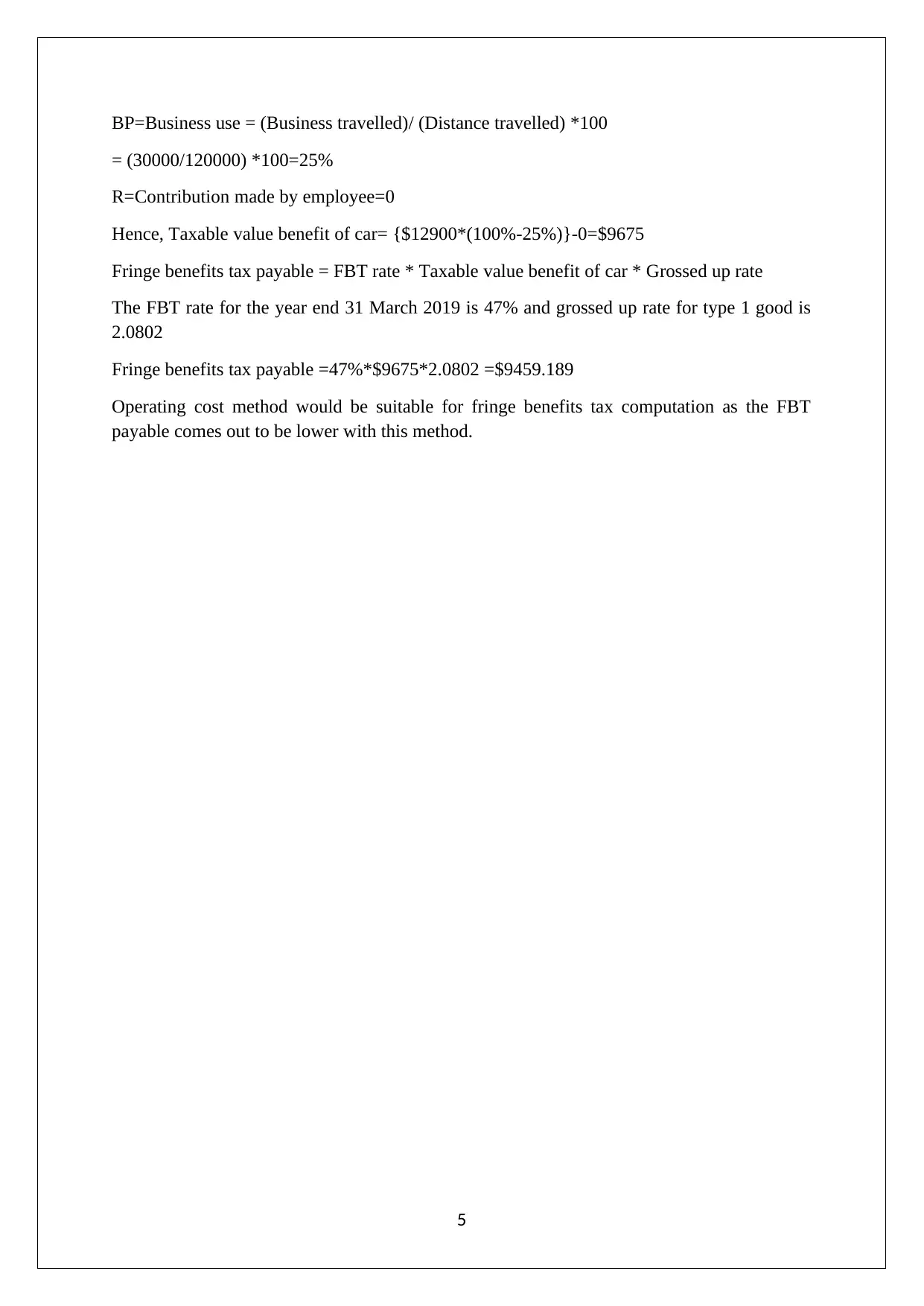
BP=Business use = (Business travelled)/ (Distance travelled) *100
= (30000/120000) *100=25%
R=Contribution made by employee=0
Hence, Taxable value benefit of car= {$12900*(100%-25%)}-0=$9675
Fringe benefits tax payable = FBT rate * Taxable value benefit of car * Grossed up rate
The FBT rate for the year end 31 March 2019 is 47% and grossed up rate for type 1 good is
2.0802
Fringe benefits tax payable =47%*$9675*2.0802 =$9459.189
Operating cost method would be suitable for fringe benefits tax computation as the FBT
payable comes out to be lower with this method.
5
= (30000/120000) *100=25%
R=Contribution made by employee=0
Hence, Taxable value benefit of car= {$12900*(100%-25%)}-0=$9675
Fringe benefits tax payable = FBT rate * Taxable value benefit of car * Grossed up rate
The FBT rate for the year end 31 March 2019 is 47% and grossed up rate for type 1 good is
2.0802
Fringe benefits tax payable =47%*$9675*2.0802 =$9459.189
Operating cost method would be suitable for fringe benefits tax computation as the FBT
payable comes out to be lower with this method.
5
⊘ This is a preview!⊘
Do you want full access?
Subscribe today to unlock all pages.

Trusted by 1+ million students worldwide
1 out of 6
Related Documents
Your All-in-One AI-Powered Toolkit for Academic Success.
+13062052269
info@desklib.com
Available 24*7 on WhatsApp / Email
![[object Object]](/_next/static/media/star-bottom.7253800d.svg)
Unlock your academic potential
Copyright © 2020–2025 A2Z Services. All Rights Reserved. Developed and managed by ZUCOL.





